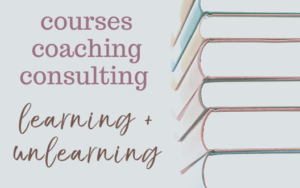This spring I’m teaching a new course titled “Contemplative Writing.” I’ve visualized the course design through triangulation, or three intersecting points that rely on the others for fuller understanding. Like a compass, triangulation helps with navigating complicated terrain. It shows locations (or ideas) in relation to each other, highlighting multiplicity. In the case of “Contemplative Writing,” triangulation brings together three semester-long focuses, audiences, and goals:
- 3 intersecting focuses = writing, justice, and contemplation/mindfulness
- 3 audiences (or spheres of interaction) = self, others, and institutions
- 3 goals = rhetorical flexibility, self-awareness, and courage in writing/speaking
To cover this complicated terrain, the students and I are journaling and doing regular (almost-daily) contemplative practices, while also pursuing “Projects That Matter” (research and activist writing). To keep me writing and practicing alongside the students, I’ve been doing some form of contemplative journaling, meditation, or movement daily.
Some days, I’ve been responding to the writing prompt that gives this blog its name, checking in with my heart, head, and hands:
- Heart: What am I feeling?
- Head: What am I thinking?
- Hands: What am I going to do?
Through these check-ins, I have been triangulating intellectual, emotional, and embodied knowledges.
Recently, I discovered a yoga-asana (movement) video that essentially asks the same questions through a 25-minute “Head & Heart Reset”:
This Yoga with Adrienne video has resonated with me because I want to build physical strength to carry a hiking backpack, and it includes several strength-building poses. While I typically prefer gentle and super slow asana, this flowing practice seems to be opening the energetic pathways connecting my heart, head, and hands (as well as my gut, tear ducts, and held-within knowing).
The practice opens with wrapping arms around the shoulders, giving myself a hug, as I’m striving to do daily. It ends with deep breathing to carry energetic connectedness off the mat and into all communication.
While in the past I’ve practiced yoga through writing, now I’m channeling writing through yoga. I’m reminded of the importance of nurturing my body and its wisdom in order to create and share wisdom through writing.
Such realizations are also showing me that triangulation is much more than a navigation tool, research method, or course design. Triangulation is why I understand writing as connected with embodiment and everyday living. It’s why I associate yoga and other contemplative, spiritual practices with the work of countering injustice and investing in more equitable relations. And it’s why I strive to connect the heart, head, and hands.
Said differently, triangulation helps me not only navigate complicated terrain but also remember that no guiding principle stands alone. May I continue to learn and make meaning in multiple ways. May I continue to open to what emerges through varied contemplative practices. May I continue to weave triangulated webs of striving (with an attitude of try-try again) to live a life for justice.
—
This post is written by Beth Godbee for Heart-Head-Hands.com. For more posts like this one, you might try “Gentle Yoga for Releasing Burdens,” “40 Days of Yoga Nidra,” and “Practicing Yoga Through Writing.” Please also consider following the blog via email. Thanks!





Once again, you’ve inspired me, Beth. Also, this reminds me of the YMCA and the triangle of spirit, mind, and body. I worked for the Y for many years, so the idea of triangulation resonates with me, too. Thank you.
Sarah, thanks for sharing this! I’ve joined the Y this year, and yet I never knew about this triangle. You’ve sent me on a fun expedition researching this triangle. 🙂 You’ve also reminded me of my own history with 4-H: head, heart, hands, and health. I was a 4-H member for many years, so I’m realizing now this must have seeped in deep. With love, Beth